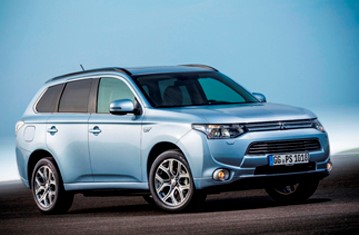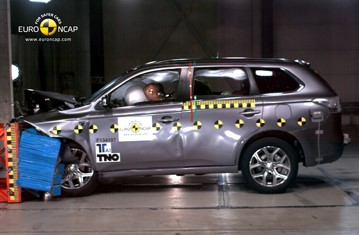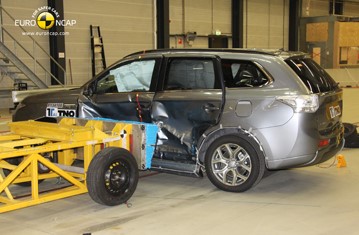Find more information in the General Comments section of the assessment
Find more information in the Rating Validity tab of the assessment
- See More
- See More
- See More
- See More
- Good
- Adequate
- Marginal
- Weak
- Poor
 Passenger
Passenger
 Driver
Driver
 Front Seat
Front Seat
 Car
Car
 Pole
Pole
- Good
- Adequate
- Marginal
- Weak
- Poor


Passenger
outboard
center
Fitted to the vehicle as standard
Not fitted to the test vehicle but available as option
Not Available
-
Infants up to 13 kg
-
Infants and toddlers up to 18 kg
-
Toddlers from 9 to 18 kg
-
Toddlers over 18 kg
Easy
Difficult
Safety critical
Not allowed
| Seat Position | ||||
|---|---|---|---|---|
| Front | 2nd row | |||
| Passenger | Left | center | Right | |
| Maxi Cosi Cabriofix (Belt) | ||||
| Britax Römer King Plus (Belt) | ||||
| Britax Römer Duo Plus (ISOFIX) | ||||
| Britax Römer KidFix (Belt) | ||||
| Maxi Cosi Cabriofix & EasyFix (Belt) | ||||
| Maxi Cosi Cabriofix & EasyFix (ISOFIX) | ||||
| BeSafe iZi Kid X3 ISOfix (ISOFIX) | ||||
| Maxi Cosi Pearl & Familyfix (ISOFIX) | ||||
| Britax Römer KidFix (ISOFIX) | ||||
Easy
Difficult
Safety critical
Not allowed
Based on dummy readings in the dynamic tests, the Outlander PHEV svored maximum points for its protection of the 1½ year infant. In the frontal impact, forward movement of the head of the 3 year dummy, sat in a forward-facing restraint, was not excessive and deceleration of the chest indicated fair protection of this body area. In the side impact, both dummies were properly contained by the protective shells of their restraints, minimising the likelihood of head contact with parts of the vehicle interior. The front passenger airbag can be disabled to allow a rearward-facing child restraint to be used in that seating position. Clear information is provided to the driver about the status of the airbag and the system was rewarded. The dangers of using a rearward-facing restraint in that seat without first disabling the airbag are clearly indicated in the car. Mitsubishi will update the user manual for the Outlander PHEV to make clear which categories of child restraints are suitable for which seating positions, and the score reflects this updated information. Earlier cars would have received the same star rating as the changes in the manual have only a small influence on the score.
- Good
- Adequate
- Marginal
- Weak
- Poor

Head Impact 17.1 Pts
Pelvis Impact 0.0 Pts
Leg Impact 6.0 Pts
The bumper scored maximum points for its protection of pedestrians' legs. However, the front edge of the bonnet was poor in all areas tested and scored no points. The bonnet surface provided predominantly good or adequate protection to the head of a struck pedestrian with some poor results recorded only on the stiff windscreen pillars.
- Good
- Adequate
- Marginal
- Weak
- Poor
| Speed Limitation Function | Manually Set |
| System Name | ASC | |
| Performance | ||
| Vehicle Yaw Rate @ COS + 1.00 s | 2.802% | meets ECE requirements |
| Vehicle Yaw Rate @ COS + 1.75 s | 2.118% | meets ECE requirements |
| Lateral Displacement @ BOS + 1.07 s | 2.98 m | meets ECE requirements |
| Applies To | All seats | ||
| Warning | Driver Seat | Front Passenger(s) | Rear Passenger(s) |
| Visual | |||
| Audible | |||
|
|||
The Outlander PHEV has electronic stability control as standard, and met Euro NCAP's test requirements. The front and rear seats are protected by a standard-fit seatbelt reminder system and the car has a driver-set speed limitation device which met test requirements for systems of that type.
- Specifications
- Safety Equipment
- Videos
- Advanced Rewards
- Rating Validity
Specifications
Tested Model Mitsubishi Outlander PHEV, 2.0 petrol plug-in hybrid 'Intense+', LHD
Body Type - 5 door SUV
Year Of Publication 2013
Kerb Weight 1810kg
VIN From Which Rating Applies - applies to all Outlander PHEV's of the specification tested
Class Small SUV
Safety Equipment
Note: Other equipment may be available on the vehicle but was not considered in the test year.
Fitted to the vehicle as standard
Fitted to the vehicle as option
Not fitted to the test vehicle but available as option
Not Available
Not Applicable
Videos
Advanced Rewards
Rating Validity





Find more information in the General Comments section of the assessment
The Mitsubishi Outlander PHEV is a hybrid-engined version of the Outlander tested last year by Euro NCAP. As it is heavier, all of the main crash tests have been re-done, along with tests to the ESC system. As Euro NCAP's method for pedestrian testing has changed since last year, the bonnet tests have also been repeated on the hybrid vehicle.
 Share
Share










The passenger compartment remained stable in the frontal impact. Dummy readings showed good protection of the knees and femurs of both the driver and passenger. Mitsubishi showed that a similar level of protection would be provided to occupants of different sizes and to those sat in different positions. Readings in the driver dummy's tibia indicated a marginal level of protection of the lower legs. In the side barrier test, the Outlander PHEV scored maximum points, with good protection of all body regions. In the more severe side pole test, dummy readings of chest compression indicated marginal protection of the chest. The front seats and head restraints provided good protection against whiplash injuries in the event of a rear-end collision.